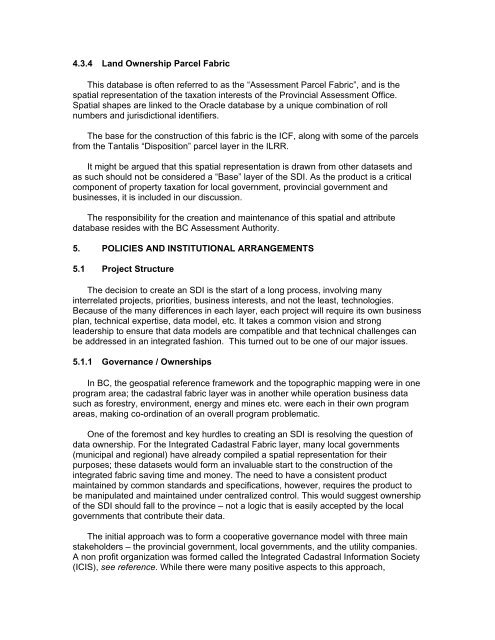paper - Global Spatial Data Infrastructure Association
paper - Global Spatial Data Infrastructure Association
paper - Global Spatial Data Infrastructure Association
You also want an ePaper? Increase the reach of your titles
YUMPU automatically turns print PDFs into web optimized ePapers that Google loves.
4.3.4 Land Ownership Parcel Fabric<br />
This database is often referred to as the “Assessment Parcel Fabric”, and is the<br />
spatial representation of the taxation interests of the Provincial Assessment Office.<br />
<strong>Spatial</strong> shapes are linked to the Oracle database by a unique combination of roll<br />
numbers and jurisdictional identifiers.<br />
The base for the construction of this fabric is the ICF, along with some of the parcels<br />
from the Tantalis “Disposition” parcel layer in the ILRR.<br />
It might be argued that this spatial representation is drawn from other datasets and<br />
as such should not be considered a “Base” layer of the SDI. As the product is a critical<br />
component of property taxation for local government, provincial government and<br />
businesses, it is included in our discussion.<br />
The responsibility for the creation and maintenance of this spatial and attribute<br />
database resides with the BC Assessment Authority.<br />
5. POLICIES AND INSTITUTIONAL ARRANGEMENTS<br />
5.1 Project Structure<br />
The decision to create an SDI is the start of a long process, involving many<br />
interrelated projects, priorities, business interests, and not the least, technologies.<br />
Because of the many differences in each layer, each project will require its own business<br />
plan, technical expertise, data model, etc. It takes a common vision and strong<br />
leadership to ensure that data models are compatible and that technical challenges can<br />
be addressed in an integrated fashion. This turned out to be one of our major issues.<br />
5.1.1 Governance / Ownerships<br />
In BC, the geospatial reference framework and the topographic mapping were in one<br />
program area; the cadastral fabric layer was in another while operation business data<br />
such as forestry, environment, energy and mines etc. were each in their own program<br />
areas, making co-ordination of an overall program problematic.<br />
One of the foremost and key hurdles to creating an SDI is resolving the question of<br />
data ownership. For the Integrated Cadastral Fabric layer, many local governments<br />
(municipal and regional) have already compiled a spatial representation for their<br />
purposes; these datasets would form an invaluable start to the construction of the<br />
integrated fabric saving time and money. The need to have a consistent product<br />
maintained by common standards and specifications, however, requires the product to<br />
be manipulated and maintained under centralized control. This would suggest ownership<br />
of the SDI should fall to the province – not a logic that is easily accepted by the local<br />
governments that contribute their data.<br />
The initial approach was to form a cooperative governance model with three main<br />
stakeholders – the provincial government, local governments, and the utility companies.<br />
A non profit organization was formed called the Integrated Cadastral Information Society<br />
(ICIS), see reference. While there were many positive aspects to this approach,
















